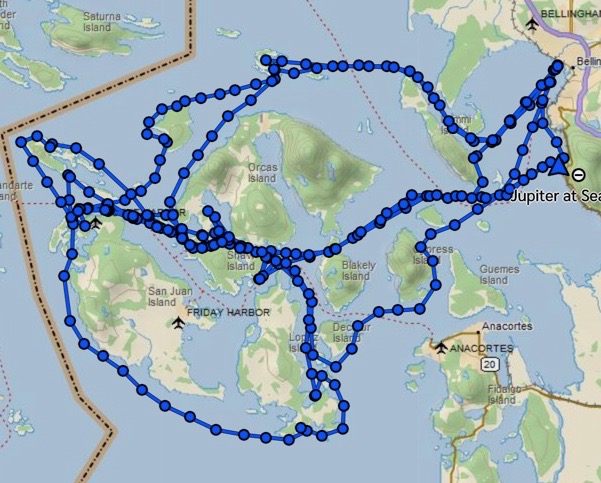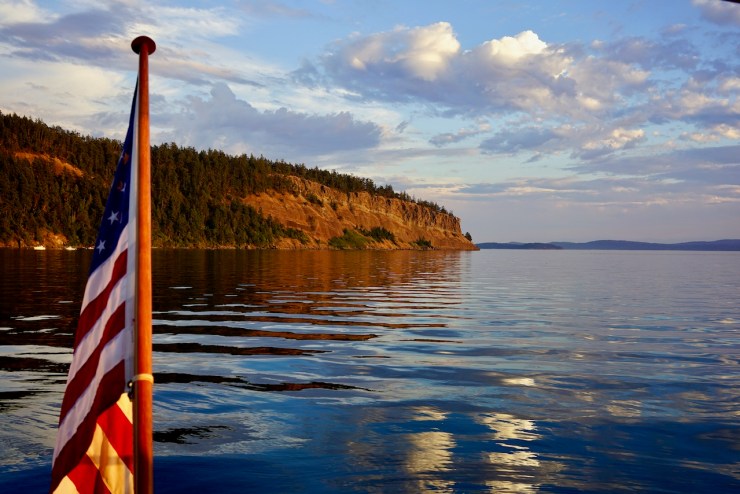Jupiter anchors up at sublimely situated Windfall Harbor in anticipation of two long-planned events.
This arresting basin lies far up the Seymour Canal inside the Glass Peninsula of Admiralty Island, and is inconvenient to most things except for a traditional seaplane arrival of friends, and access the following day to a rare and remote brown bear sanctuary.
The seaplane arrives on schedule with Penny and Craig aboard, sunshine in their pockets, loaded for bear and adventure. The aircraft coasts into Jupiter’s swim platform with pace and percussion enough to knock loose any resident barnacles.
Amphibious Assault
It is a miserable, parky morning to navigate the 3½ mile crossing in a small inflatable tender – four persons in foulest foul weather gear – traveling too long and too slowly, pawing through cold curtains of a deluge, to seek bears at Pack Creek estuary.

Expectations are further dampened by cautions from the ranger station that bears are unlikely to be active or even present this time of year. But visit we must, and our permit falls on a frightful Friday.
Arrival at Pack Creek is ultimately attained by avoiding several orange balls marking a submerged mooring line arrangement and misunderstanding onshore semaphore by a weathered ranger atop a small tombolo.
The tide is receding, coyly revealing an immense alluvial flat impatient to ground our tender.

Going ashore at tidal flats involves running the boat, outboard stopped and raised, gently onto the shore. Those hoping to maintain dry feet elbow themselves to the bow to hop on point like clumsy ballerinas up to higher ground. This rarely succeeds.
Although our bow is firmly beached and all wear rubber boots, a step into the shallow sea instantly overtops footwear flooding smartwool feet with a cold chowder of sand and algae that remains in place throughout the day.
The Laundry Line

With crew more or less ashore Jane, from Alaska Fish and Game expertly uses a clove hitch to secure our tender’s bowline to the laundry line mooring arrangement, whereby a small boat can be pulleyed out to deep water when not needed ashore for access and egress, the exact location of which is entirely determined by the synchronous height of the tide.
Habituation
Wet through from the rain, the boat-ride and the landing, we receive a safety orientation that entirely ignores hypothermia. Instead it focuses on expectation of close encounters with large and dangerous bears: remain in a tight cluster, move only along the designated routes and remain within viewing areas, do not carry food, do not raise your voices, and act like the humans bears expect to see.
Since the 1930’s generations of bear have been habituated here to the presence of human visitors.
Making our bear-approved way along the bear-approved shoreline route we find the viewing spit and Christy, a U.S. Forest Service Ranger waiting to introduce us to Pack Creek and its bears.
Within minutes an immense sow and two large cubs appear from the nearby forest as if summoned by radio. These three perform all the bear activities anyone could hope for: romping cubs, swatting mother, suckling and grazing, rearing up and lying down, rolling, sniffing, back scratching, pissing and pooping in a steamy brown bear extravaganza that moves ever closer to our location.
Christy quietly reassures and educates us on brown bear life and times, but we secretly wonder if her glistening green forest service rain garb conceals a Glock 10mm high velocity pistol – just in case.
Although we have seen and photographed numerous black and brown bears on explorations of southeast Alaska, nothing has prepared us for this intimate liaison with these magnificent wild creatures. Our close bear family, oblivious to concerned comments and continuous camera clicks, eventually moves out to the tidal flats for an all-you-can-eat clam buffet.

Evacuation
Wet and wetter in a rising wind, our team is cleared for an aggregated withdrawal from the viewing spit, returning along the shore to Jane who must be anxious to see our damp backsides disappear into the drear in order to return to better shelter. Other visitors, she tells us, are unlikely to arrive on a day such as this.
The clothes line is activated in reverse and we freshen up our boot soup as we load into the dinghy. The long return to Jupiter is enriched by an hour of grey seas over the pontoons and into our faces.
Ultimately, we climb aboard the mothership looking like denizens of the deep in a trashy horror film. Hot showers and chowders restore the brown bear explorers, whose outerwear take two days to fully dry.
Penny and Craig wonder what just happened.
“Instead of falling, the rain, mixed with misty shreds of clouds, was flying in level sheets, and the wind was roaring as I had never heard wind roar before.”
John Muir ~ Travels in Alaska, 1879
Rain Boot Chowder
Alaskans prize the “tips” from Sablefish, known locally as Black Cod, which are pulled by hand from the collar meat. Their rich velvety texture is ideal in this hearty chowder. Any firm white fish will suffice.
Dice bacon and cook until crisp in a soup pot. Remove crispy critters and set aside, leaving drippings in the pan. Thinly slice sweet onion and sauté in the drippings until golden. Add a sockful of small potato halves to the pan, and toss to coat well. Add rich fish stock just to cover, cast in the cod tips, simmer gently for ten minutes then refrigerate and let rest overnight.
Reheat the stew. Pour in cream and a generous slug of sherry. Season with salt and black pepper to taste. Stir gently until it reaches a steaming simmer. Ladle into warm bowls and top with reserved bacon bits.


























































































































































































































